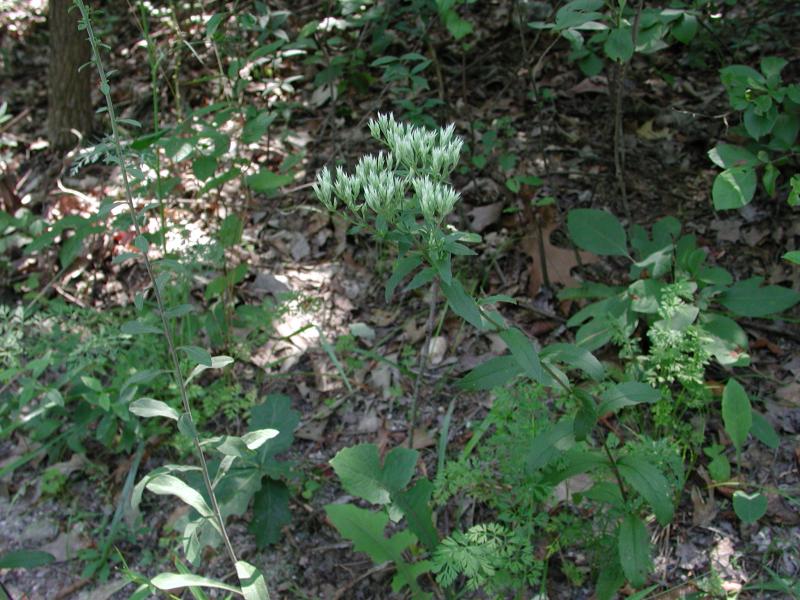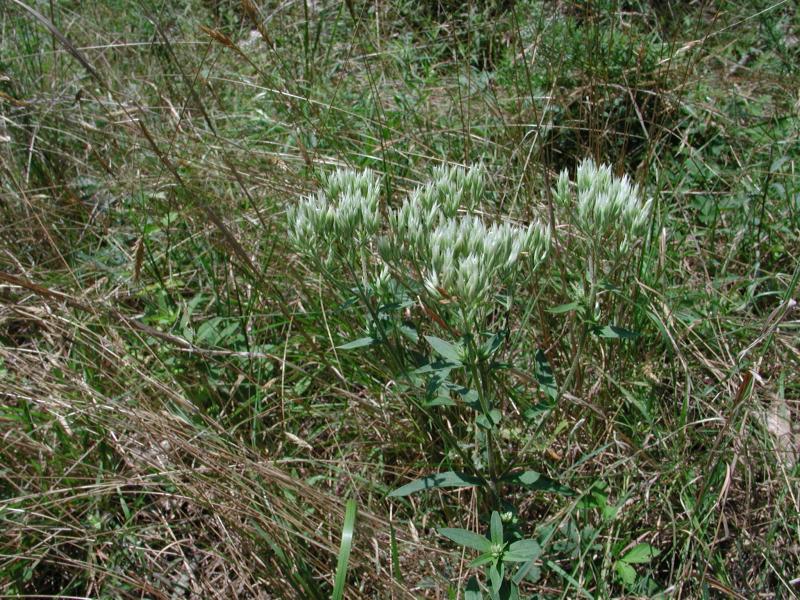Veined Thoroughwort
Eupatorium subvenosum (A. Gray) E.E. Schill.
- Class
- Dicotyledoneae (Dicots)
- Family
- Asteraceae (Aster Family)
- State Protection
- Threatened
Listed as Threatened by New York State: likely to become Endangered in the foreseeable future. For animals, taking, importation, transportation, or possession is prohibited, except under license or permit. For plants, removal or damage without the consent of the landowner is prohibited.
- Federal Protection
- Not Listed
- State Conservation Status Rank
- S2S3
Imperiled or Vulnerable in New York - Very vulnerable, or vulnerable, to disappearing from New York, due to rarity or other factors; typically 6 to 80 populations or locations in New York, few individuals, restricted range, few remaining acres (or miles of stream), and/or recent and widespread declines. More information is needed to assign either S2 or S3.
- Global Conservation Status Rank
- G5T4
Apparently Secure globally - The subspecies/variety is uncommon in the world but not rare; usually widespread, but may be rare in some parts of its range; possibly some cause for long-term concern due to declines or other factors. (The species as a whole is common globally.)
Summary
Did you know?
This variety may have arisen from hybridization of Eupatorium album var. album and Eupatorium serotinum (Flora of North America Editorial Committee 2006) both of which occur in small populations on Long Island.
State Ranking Justification
There are 11 existing populations, but many of these have not been seen during recent surveys. Future surveys will determine if they should be considered extirpated. There are 16 historical occurrences.
Short-term Trends
In August 2004, Steve Young resurveyed nine of twelve occurrences documented by Bob Zaremba in the 1980s, but only two of them contained any plants. The habitat of three of the sites had succeeded to woody vegetation and the open habitat was no longer there. One roadside population was probably eliminated by mowing and another roadside population had been eliminated by Phragmites. Two populations were in areas that still seemed to have good habitat, but no plants were seen. The original populations of these last two sites were only 5-10 plants. One roadside population and one population in a grassy opening by a lake were still extant, although the number of plants was reduced.
Long-term Trends
There were less than 20 historical records for the state and presently there are 11 existing populations, although many of these may no longer be extant because of succession. The plant has probably declined from historical numbers, but it is hard to tell what the future long-term trend will be.
Conservation and Management
Threats
The main threat to this plant is the succession of its open habitat to woody plants. Development may also threaten sites, as well as Phragmites.
Conservation Strategies and Management Practices
This species needs disturbance to reduce competition from woody plants or more aggressive herbaceous plants, but too much direct disturbance to the plants will reduce the population. Its habitat could be disturbed in the non-growing season to open it up for seed germination and colonization, but direct disturbance should be prevented during the growing season.
Research Needs
A study of habitat requirements is needed to determine why this plant only occurs on a small portion of the available disturbed sandy habitats.
Habitat
Habitat
In New York, Eupatorium album var. venosum has been found in dry, sandy, open habitats. These include roadsides and mowed areas in pine barrens, cemeteries, interdunal swales, dry oak forests, lake or pond margins, successional old fields, and railroad and powerline right-of-ways (New York Natural Heritage 2010). Dry, open pine barrens and sandy shores (FNA 2006). Dry, open woods, especially in sandy pinelands (Gleason and Cronquist 1991).
Associated Ecological Communities
- Coastal plain pond shore
(guide)
The gently sloping shore of a coastal plain pond with seasonally and annually fluctuating water levels. Plants growing on the pond shore vary with water levels. In dry years when water levels are low there is often a dense growth of annual sedges, grasses, and herbs. Submerged and floating-leaved aquatic plants, such as fragrant waterlily and pondweeds, may become "stranded" on the exposed shore. In wet years when the water level is high only a few emergents and floating-leaved aquatics may be noticeable. T
- Dwarf pine plains
(guide)
A woodland community dominated by dwarf individuals of pitch pine and scrub oak that occurs on nearly level outwash sand and gravel plains in eastern Long Island. The soils are infertile, coarse textured sands that are excessively well-drained.
- Mowed roadside/pathway
A narrow strip of mowed vegetation along the side of a road, or a mowed pathway through taller vegetation (e.g., meadows, old fields, woodlands, forests), or along utility right-of-way corridors (e.g., power lines, telephone lines, gas pipelines). The vegetation in these mowed strips and paths may be dominated by grasses, sedges, and rushes; or it may be dominated by forbs, vines, and low shrubs that can tolerate infrequent mowing.
- Pitch pine-oak forest
(guide)
A mixed forest that typically occurs on well-drained, sandy soils of glacial outwash plains or moraines; it also occurs on thin, rocky soils of ridgetops. The dominant trees are pitch pine mixed with one or more of the following oaks: scarlet oak, white oak, red oak, or black oak.
- Pitch pine-scrub oak barrens
(guide)
A shrub-savanna community that occurs on well-drained, sandy soils that have developed on sand dunes, glacial till, and outwash plains.
- Successional old field
A meadow dominated by forbs and grasses that occurs on sites that have been cleared and plowed (for farming or development), and then abandoned or only occasionally mowed.
Associated Species
- Phragmites australis ssp. australis
- Pinus rigida (pitch pine)
Range
New York State Distribution
This herb is currently known from Suffolk County on Long Island and on Staten Island. There are historical records from Nassau County and the Bronx.
Global Distribution
This herb ranges from Long Island and Staten Island in New York south to Delaware and the District of Columbia. It is most common in New Jersey and absent from Maryland.
Identification Comments
General Description
Eupatorium album var. subvenosum is a perennial herb in the aster family. The single stems grow from 40 to 100 cm tall from short rhizomes or caudices, and are sparsely branched distally and pubescent throughout. The leaves are mostly opposite (some distal leaves may be alternate), simple, 3-nerved from their bases, and sessile, 1 to 2 cm wide and 3 to 4 times as long. They have sub-entire to serrulate margins and may be bristle-covered (denser on midribs and veinlets) or nearly smooth, and are usually gland-dotted. The infloresence is corymbiform and made up of disc flowers only, arranged into heads of five florets each, the corollas are white and 4 to 4.5 mm long, and the calices form pappi of 40-50 bristles 3.5 to 4.5 mm long. Each head is subtended by 9-15 involucral bracts (phyllaries), each 1.5 to 9 mm long and pubescent on their outer sides (FNA 2006).
Best Life Stage for Proper Identification
Flowering or fruiting specimens are needed for identification.
Similar Species
Eupatorium pilosum has leaf blades mostly 1 to 2 times as long as wide, while E. album's leaves are 3 to 4 times as long as wide. Eupatorium album var. album, the only other variety of E. album found in New York, has leaves with coarsely serrate margins and obtuse to rounded tips, while E. album var. venosum has leaves with subentire, serrulate, or serrate margins and acute tips.
- Vegetative
- Flowering
- Fruiting
The time of year you would expect to find Veined Thoroughwort vegetative, flowering, and fruiting in New York.
Veined Thoroughwort Images
Taxonomy
Veined Thoroughwort
Eupatorium subvenosum (A. Gray) E.E. Schill.
- Kingdom Plantae
- Phylum Anthophyta
- Class Dicotyledoneae
(Dicots)
- Order Asterales
- Family Asteraceae (Aster Family)
- Order Asterales
- Class Dicotyledoneae
(Dicots)
- Phylum Anthophyta
Additional Common Names
- Trinerved White Boneset
- Whitethorough-wort
Synonyms
- Eupatorium album var. subvenosum Gray
Additional Resources
Best Identification Reference
Flora of North America Editorial Committee. 2006. Flora of North America North of Mexico. Vol. 21. Magnoliophyta: Asteridae, Part 8: Asteraceae, part 3. Oxford Univ. Press, New York. xxii + 616 pp.
Other References
Fernald, M.L. 1950. Gray's manual of botany. 8th edition. D. Van Nostrand, New York. 1632 pp.
Gleason, Henry A. and A. Cronquist. 1991. Manual of Vascular Plants of Northeastern United States and Adjacent Canada. The New York Botanical Garden, Bronx, New York. 910 pp.
Holmgren, Noel. 1998. The Illustrated Companion to Gleason and Cronquist's Manual. Illustrations of the Vascular Plants of Northeastern United States and Adjacent Canada. The New York Botanical Garden, Bronx, New York.
New York Natural Heritage Program. 2010. Biotics database. New York Natural Heritage Program. New York State Department of Environmental Conservation. Albany, NY.
New York Natural Heritage Program. 2024. New York Natural Heritage Program Databases. Albany, NY.
Weldy, T. and D. Werier. 2010. New York flora atlas. [S.M. Landry, K.N. Campbell, and L.D. Mabe (original application development), Florida Center for Community Design and Research http://www.fccdr.usf.edu/. University of South Florida http://www.usf.edu/]. New York Flora Association http://newyork.plantatlas.usf.edu/, Albany, New York
Links
About This Guide
Information for this guide was last updated on: February 23, 2011
Please cite this page as:
New York Natural Heritage Program. 2024.
Online Conservation Guide for
Eupatorium subvenosum.
Available from: https://guides.nynhp.org/trinerved-white-boneset/.
Accessed July 27, 2024.


